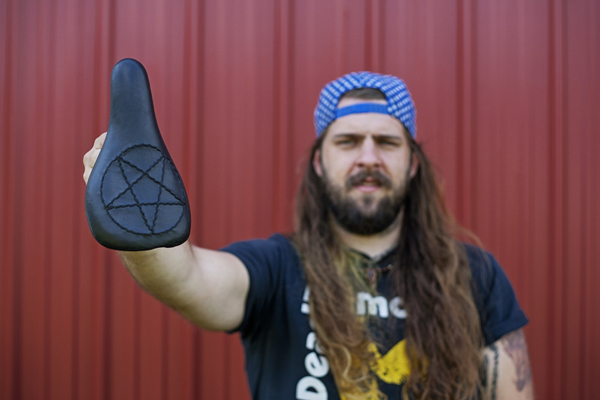
One of the things that I love most about doing this column is the fact that I have full creative control week after week. There is no one telling me what to do or how to do it. As someone who has worked in the creative industry for over a decade now there is nothing better than creating an idea from scratch and watching it come to life. That is exactly what this week’s column is all about. I recently spent some time hanging out with James Covington, the owner of Native BMX, and got the chance to pick his brain about the custom leather seats that he makes. Not very many people are out there working with their bare hands, using timeless techniques and creating truly custom pieces. It’s one of those things that you have to appreciate. In today’s BMX industry parts are and can be about as cookie cutter as they come. Companies literally just take the same parts as other companies and just stamp their name on them and call them their own. To me, there is nothing good about that. The fact that there are people out there like James giving you the option to truly add a personal touch to your bike is what makes me think there is hope for BMX after all. The reason why most of us ever got involved with riding in the first place was to stand out from the crowd and not follow the normal path that was laid out in front of us. Find out more about the whole process and give some respect to someone out there making quality, unique, American-made products that could potentially last a lifetime.
Well, let’s start this off by filling everyone in on some info on yourself.
Name: James Covington
Age: 26 years young
Hometown: Maitland, Florida
Give us a brief history of your involvement in the BMX industry.
Throughout my high school years I bounced around central Florida working at boring bike shops until I ended up at Mike Cottle’s parents bike shop where I was able to sell and service a good amount of BMX bikes. In 2006 I started working for Chad DeGroot at his skatepark in Longwood, Florida known as Mesh. Three years at Mesh put my foot into an array of doors. I started as a normal employee, and worked my way up to manager status where I handled the normal open/close operations, paying employees, picking up garbage, ordering products, running pro shop duties, and dealing with customer service for the BMX division of the park.
I also got the chance to go on Props trips and help host some amazing events and contests. My years at Mesh got me in contact with a lot of people in the BMX industry whether it was face to face meetings with pro riders, visiting riders, locals, or just talking to those involved in the plethora of companies we were sponsored by or ordered products from. Somewhere in the Mesh era I was hired by the now long gone Underground Distribution, otherwise known as UGP. At UGP I was there as a young mind helping point the distro in the direction where they could hit the hard goods market of the masses. After UGP went under I helped DeGroot open his currently successful BMX/skate shop directly across the street from the building where Mesh skatepark once stood. Now I am sinking effort into growing Native Bikes as a brand.
Where did the idea come from and what is it that originally got you into making custom seats?
I have always been a “nerd” about certain parts of a bicycle. My good friend growing up, Jarred, called me a “seat whore”. I could never keep one seat on my bike for more than a few weeks without changing the cover or moving to a totally different seat all together. In my mind the seating of a bicycle can make a big difference in the appearance and feel of a BMX bike. After years of covering Primo seats and GT drop-nose seats with Crown Royal bags and old jeans Aaron, my business partner with Native, suggested that I throw some leather on a seat. I have an insane collection of different or unique seats that I have collected over the years and started honing in my skills on some seats that I never plan to get rid of. The idea of doing custom seats just came once people started seeing the seats we were doing for our personal bikes.”
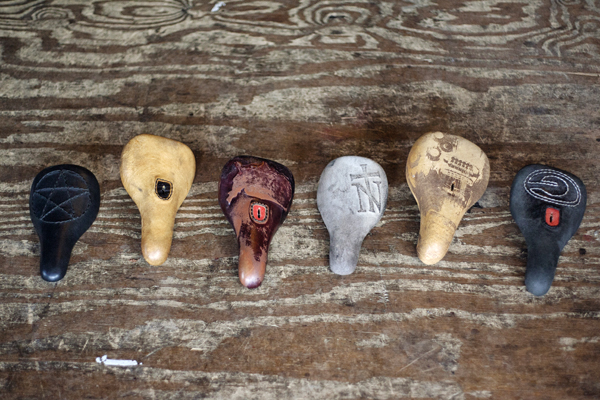
Is the whole operation run under the Native BMX name?
Yes actually. I have been doing quite a bit of leatherwork in the last few years and always putting Native on all of it. Our leather products are available exclusively through the Native BMX website or through communication via my BMX email. I think it’s cool to stick to the roots of how you started doing what you do. I have been making custom guitar straps for big bands, pistol holsters, chopper seats, and belts all under the Native BMX name. I suppose at some point Native BMX doesn’t make sense on some products but as of now the plan is to keep Native BMX as our outlet for all of our leather products BMX or not.
Can you give a rundown of the process from start to finish?
It starts with the seat blanks. I will take the seat the customer has requested out of our inventory and remove the original material. This process doesn’t seem that difficult or important but it is very crucial. Removing staples is pretty self-explanatory; pulling the original cover is a little tougher than it may sound. If you just grab and tug the vinyl covers off you can mutilate the foam underneath. If the base foam looks bumpy then you are doomed from the start. I use a variety of techniques to ensure the cover is removed smoothly. Once you have a naked seat on the workbench you pull the materials for the cover. I have self-made templates for every seat under the sun. I lay the template down, trace around, and cut. Center patches for pivotal seats and designs for the “embossed” technique I use are cut out of cowhide by hand with a razor knife. Native offers the incorporation of logos or images via hand stitching, custom screen-printing, and the embossing technique. Once the cover is laid out and the design is laid out the two come together. The foam is covered in adhesive, wrapped tightly with the cover, rolled under, and stapled. After this step I check every single staple with pliers to ensure they are anchored into the seat pan and the nose and tailpieces are re attached. All Native BMX seats are made, covered, and tooled by hand. No sewing machines are used, and I punch every damn hole by hand before sewing.
How do you decide on which materials to use?
The first determining factor in what materials to use is logo or image incorporation. Certain materials cannot be embossed or printed on. Embossing can typically only be done with thinner cowhides, deerskins, and pigskins. Screen-printing is the technique used for more intricate designs. Designs or logos can be printed on certain softer materials but to prolong life we typically only print on suede sided materials. The ink really grabs the grain of the suede well. The next determining factor would be matching a color scheme. Most leathers come in earth tones like your typical tan, black, and brown. The leather distro that I work with has a ton of different colored materials straight from the warehouse but we also do a good amount of custom dying and color matching. Lastly I ask people how they treat their bike. If a bike is not babied I will use thicker or more rugged materials to ensure the seat “looks” good for as long as it can.”
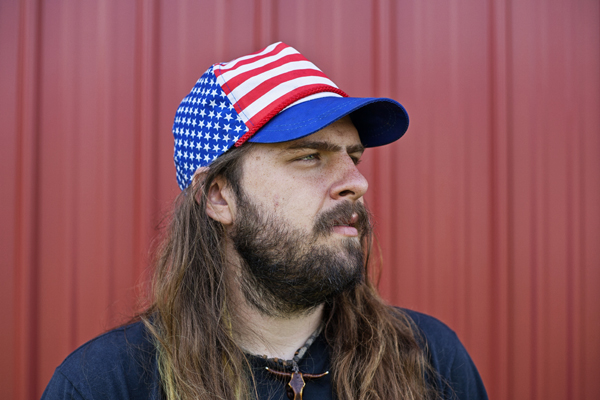
What kind of options do people have when it comes to customization?
We can cover any size or style bicycle seat. We have a lot of bases to choose from in stock, ready to go. As for customization the sky is the limit. I feel like we have just started scratching the surface of what we can do. Customization can include foam/shape modification, screen-printing integration, logo embossing integration, or design embroidery integration. Aaron has always pushed the limits on what we can try to do from adding padding, to swirl dying the leather covers, to burning cover materials, etc. So much can be done, we just need the suggestions from anyone out there who is interested in getting a custom seat made.
What is the cost to get a full custom seat made and what should people know before going into the process?
The cost of a custom seat varies depending on materials, the type of design being incorporated, how detailed the logo or design is, and the cost of the seat base desired. They start at $55 with our simple Native deer skin-drop nose-railed seats and can go up to the $100 range. I modify the price each time to cover my ass. Time is money, you know?
Do you use your own seat or do you guys have a list of seats that riders can choose from?
The behind-the-scenes of the BMX seating world is pretty boring and bland. There are only a hand full of Pivotal bases really out there and a vanishing amount of railed seats. People don’t really know that most Pivotal’s have one base and multiple foam molds on top. We have the three basic Pivotal styles in stock ranging from slim, medium, and fat. Other than that we have slim, medium, and fat railed style seats along with tripod bases, one-piece combos, and a ton of random road/fixie seats. If riders are picky about a certain base and we don’t have the blank in stock we will get a hold of what the customer needs.
What is it about doing custom made seats that keeps you at it?
There are few things that one can do to make their bike stand out in a crowd or give it personality these days. I get insanely over joyed to see a seat that I made on somebody’s bike that has been well ridden and worn in. Leather just looks good with time and age. Also, people don’t understand that a seat with the proper cover can potentially last forever. I always pay attention to the details and I keep doing what I am doing for those out there that are like-minded.
I know you mentioned getting a bunch of tools passed down from your father, what kind of specific tools do you use for the process?
My father handcrafted Western style pistol holsters and rifle bags from cow hide. I used to watch what he was doing and think that it was way more work that the out come was worth. Taking a thick material and hand punching every single hole before sewing pieces together. It turns out there is a tool for everything in life and when he passed away he left behind a set of tools that made this whole custom seat thing possible. Cutting, hole punching, stamping, and hand sewing tools were scattered on his workbench just asking to be used. I finished a few of his projects while teaching myself how to crudely use some of the tools. Now I use them all often and add to the collection as I find new techniques to make my life easier.
Can someone request a certain material or do you just go for it with what you have laying around?
I have hundreds and hundreds of square feet of leather materials ready to be cut up for whatever the project may be. I’ve got a good relationship with the guys working at our local leather distro. They flag me down to let me know when materials that fit our needs are on sale or close out. I am also an elite member of the distro, which allows me to get large amounts of materials at a very low price.
Where can people find out more about this whole process and what is the best way for people to get a hold of you?
I typically update the “work portfolio” as much as possible and provide a description of each seat at nativebikes.tumblr.com but the absolute best way to get a hold of me is through my email which is James@nativebmx.com. I check it as often as I can and am as informative as possible when emailing customers back and forth with the creative process involved in choosing the recipe for the seat they want.
About how long does a fully custom seat order take from idea to reality?
Realistically, once the design is finalized it can take a week to three weeks depending on how far backed up the custom orders are. Believe it or not we are extremely busy with custom leatherwork some times.
Give a little info on each of the individual seats that I shot photos of and talk about each one, and the idea behind it and the thought process from start to finish.
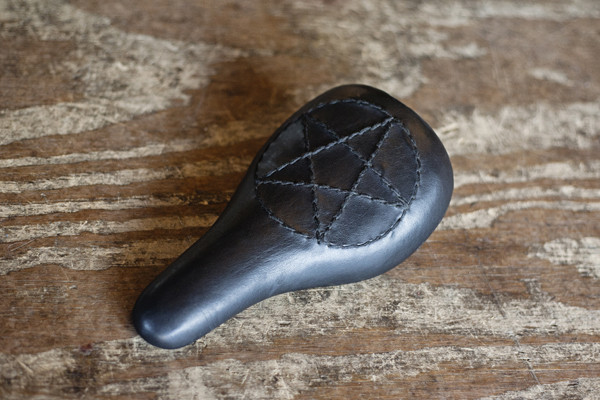
1. The first one is my personal tripod seat. It started as the thin version of the Fly bikes “Dos” seat. I modified the shape of the foam to be totally flat on top. Once the shape was to my liking I hand embroidered a pentagram into some fine, black pig skin and wrapped it nice and tight.
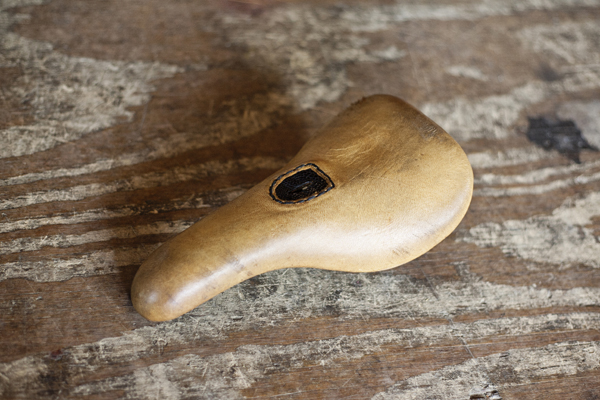
2. This seat is a pretty plain seat. It was based around one of the custom pans that Aaron made. I started with a clear pan and wrapped it in saddle tan deerskin with a black ostrich center patch. I didn’t want to invest a lot of time into the cover not knowing if the pan was going to hold up or not. The pan ended up being amazing and super strong though.
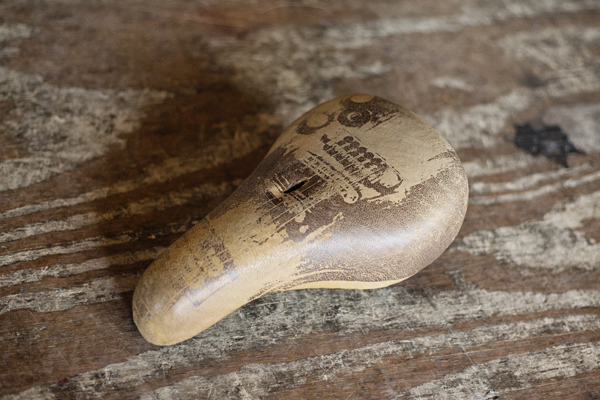
3. This is Aaron’s “fat” Pivotal seat. Also sitting on a custom Pivotal base this seat is saddle tan deer skin with the image of Aaron’s custom 1979 Gibson “The Paul” screen printed over the top. No Pivotal patch, just a clean and simple slit.
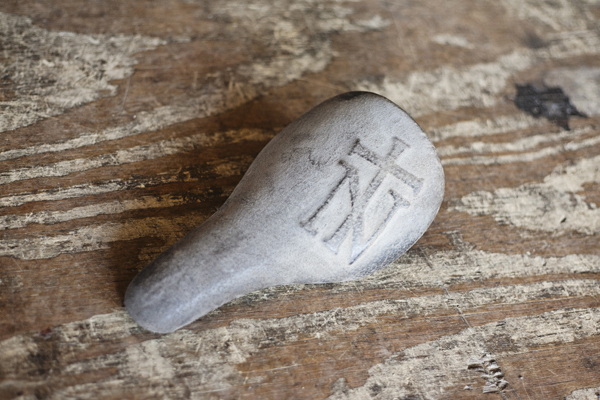
4. Another Fly “Dos” tripod seat. This belongs to one of our team guys named Jared. It has an “embossed” Native logo underneath a light brown pig suede.
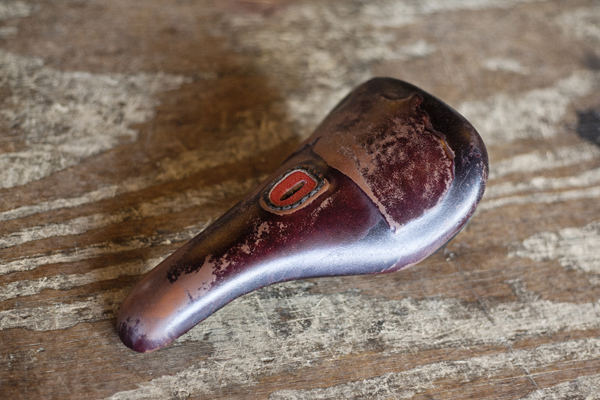
5. USA! This is a thin Pivotal made with an interesting brown cowhide that wears great. It has the outline of the United States embossed just below a red ostrich center patch.
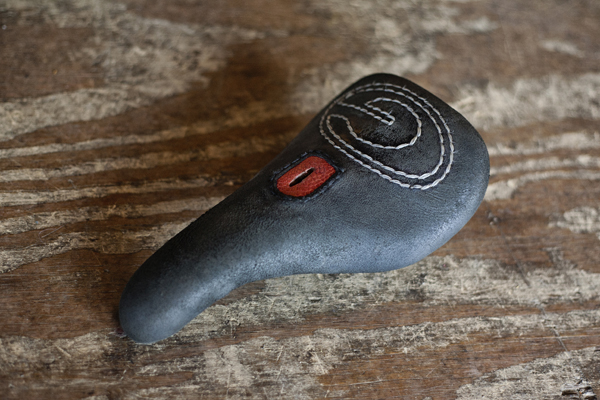
6. “Lastly we have Austin Hunnicutt’s custom thin Pivotal with a hand stitched University of Georgia logo. This seat was made quite some time ago with black deer skin and also has a red ostrich center patch.”
You also mentioned doing a custom Pivotal mold as well. What’s the deal with that?
There is a semi long history to this one. I share a workspace with Aaron Sarkisian and Maxwell Hartley. Max is a carpenter and also specializes in sculpting, molding, and casting. After years of school in Philly, Max passed some general knowledge of molding and casting to Aaron. Aaron doesn’t just “kind of” do something. He is the type of guy that wants to do things the correct way and also likes to have a good understanding of something if he is putting time and effort into it. So, after research/trial and error he started playing with making silicone molds of smaller items and casting them with various resins and foams. Here at Native we are very proud of everything we do inside of the United States and Aaron and I talked about how cool a 100% American Pivotal seat would be. I recognized things in a Pivotal pan that I saw as weak points and corrected them with clay braces and Aaron spent a few days crafting a beautiful silicone mold of the seat pan that we had modified. The specifics of the materials used are all over the place. Aaron poured less than ten pans of different mixes to see what was brittle or soft. There are a few floating around to see if they will last under different styles of riding. It’s crazy what an idea can turn into once it enters Aaron’s head.”
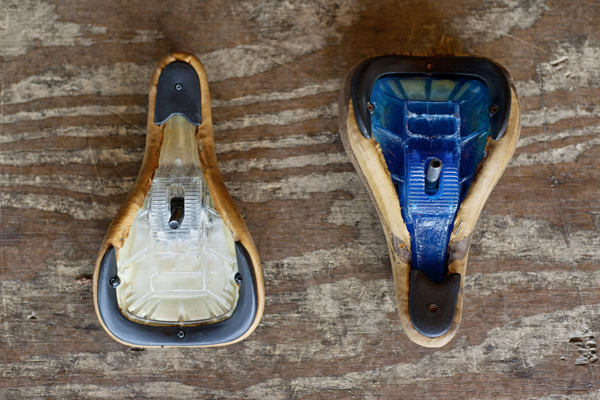
After reading this, if someone were thinking about adding that personal touch to their bike, which is hard to do these days, what would you say to convince them to go for it?
I would simply ask them if they ever been able to design and create your own signature seat. It essentially is what we are doing for people. We can take an idea from our customer’s heads and make one-off pieces that will look great and last forever. Leather is such an awesome material, especially applied to the seating area of a bicycle.
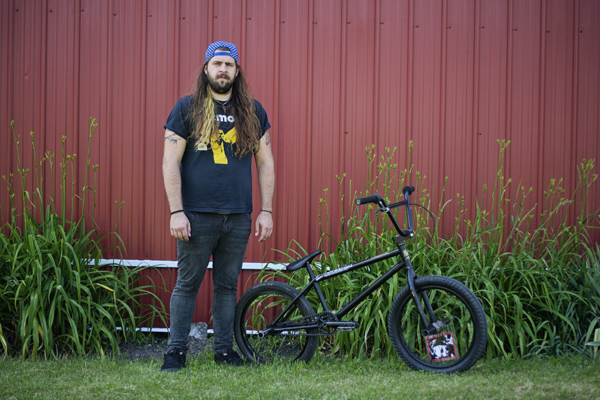
This is where you give some shout-outs and thanks so go for it.
I have to thank my business partner Aaron Sarkisian for always being around to help me with anything I have ever needed. I would like to thank my mother and sister for being extremely supportive of me deciding to do what I want to do with my life. Every person that is on our team or has ever purchased a Native product because they believed in what we are doing and the direction we are going in. A huge thanks goes out to Matt Coplon and Profile Racing/Madera for always keeping our riders and myself on the finest BMX products available. Thanks to Larry at ODI for keeping the Native teams hands comfy. GGSB screen-printing for cranking out the finest soft goods that money can buy. Thanks to Paul Sarkisian for providing 71n for all of us to learn how to live life. Thanks to Shops like Mr. B’s, The Daily Grind, Circuit, Goods, and Empire for existing. I want to thank Dave McDermott for always being up for riding a good flat ledge or half assed Florida street spot and last but not least; I gotta’ thank Tim Covington, my father, for teaching me to be a man and paving the way for my life to be a success.
On that note, be sure to check back next Wednesday for the seventy second edition of Through the Lens and as always feel free to leave any questions in the comments section or email me directly at info@jeremypavia.com and I will hit you back as soon as I can. Feel free to follow me on Twitter and Instagram as well @jeremypavia.
Want more Through The Lens? Check out past weeks below!
